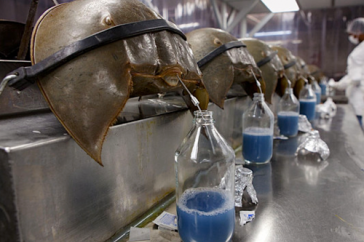UNH Researcher: The Horseshoe Crabs Are Coming!

The blue blood of horseshoe crabs is highly prized by the biomedical industry.
Credit: Mark Thiessen, National Geographic Magazine Staff
DURHAM, N.H. - They've got blue blood, more than four eyes, have been around since the time of the dinosaurs, and could save your life. It's no wonder that University of New Hampshire graduate student Helen Cheng is so passionate about horseshoe crabs.
In the coming months, as the creatures stage their annual spawning assault on the beaches of New Hampshire's Great Bay, Cheng hopes to share that enthusiasm with beachcombers, boaters, and area residents as she gathers data on the population of this prehistoric species. "If people spot large groups of them in the estuary or see them along the shoreline, I want to know," says Cheng, who's pursuing a Master of Science degree in zoology.
Her research, overseen by professor of zoology Win Watson, aims to conduct the first major monitoring of the general population of the horseshoe crab in Great Bay. At survey sites around the bay - Sandy Point near the Great Bay Discovery Center in Greenland, near Great Bay Marina in Newington, Moody Point in Newmarket, and Adams Point near UNH's Jackson Estuarine Laboratory and Jackson's Landing, both in Durham - Cheng will track the number, size, and characteristics of the horseshoe crab population. In addition, the researchers have tagged nearly 300 horseshoe crabs that they plan to track.
"If we don't find out more about these animals, we could lose this living fossil," Cheng says, noting that they have existed for 350 million years.
Horseshoe crab monitoring efforts done in other states, from Massachusetts to Florida, have indicated that horseshoe crab populations there are in decline. Cheng's monitoring project is essential to understanding the status of the horseshoe crab population in New Hampshire, specifically Great Bay Estuary, which prior to her current study, was virtually unknown.
The dinner plate-sized armored creatures - not true crabs, but related to spiders and scorpions -- are highly valued for their unique blue blood, which is widely used in the biomedical industry to ensure that injectable medications like drugs and vaccines, as well as medical devices, are free of bacterial contamination.
"I don't think there's any one human being who hasn't been touched by horseshoe crabs. Their blue blood is the equivalent of gold," Cheng says.
Horseshoe crabs are also used as bait in the eel and whelk, or conch, fisheries, and, like many coastal species, they face growing threats from destruction of their habitat by development.
As water temperatures warm, horseshoe crabs - which live primarily in estuaries or bays- leave their deep-water winter homes to crawl ashore and spawn, keeping Cheng busy with monitoring throughout May and June. They can be so thick on the beaches at each high tide that observers compare them to cobblestones.
Cheng is reaching out to boaters, recreational fishermen, and homeowners around Great Bay to alert her if they spot horseshoe crabs, especially large groups of them, noting where they spot them, how many they see, and whether any horseshoe crabs have tags.
"Having more 'eyes' to look for tagged animals and note where they are will be most beneficial," says Cheng. Horseshoe crab spotters can report their findings by email to Cheng or Watson (hrw24@wildcats.unh.edu, win@unh.edu), or by calling their lab (603-862-4019).
Read more about Helen Cheng and her work with horseshoe crabs in Great Bay at her blog: http://micropopbio.org/hcheng/gbehscsurveys.
Photographs available to download:
/unhtoday/news/releases/2013/may/cheng.jpg
Helen Cheng, graduate student at the University of New Hampshire, shows off a Great Bay horseshoe crab.
Credit: Julian Russell for UNH Photographic Services
/unhtoday/news/releases/2013/may/tagged.jpg
Mating horseshoe crabs wear button tags placed by Helen Cheng and the Watson lab.
Credit: Helen Cheng
/unhtoday/news/releases/2013/may/hsc.jpg
A "conga line" of mating horseshoe crabs.
Credit: Helen Cheng
/unhtoday/news/releases/2013/may/photons.png
The blue blood of horseshoe crabs is highly prized by the biomedical industry.
Credit: Mark Thiessen, National Geographic Magazine Staff
The University of New Hampshire, founded in 1866, is a world-class public research university with the feel of a New England liberal arts college. A land, sea, and space-grant university, UNH is the state's flagship public institution, enrolling 12,200 undergraduate and 2,300 graduate students.
-30-
Latest News
-
December 4, 2025
-
November 26, 2025
-
November 6, 2025
-
November 5, 2025
-
October 24, 2025














































